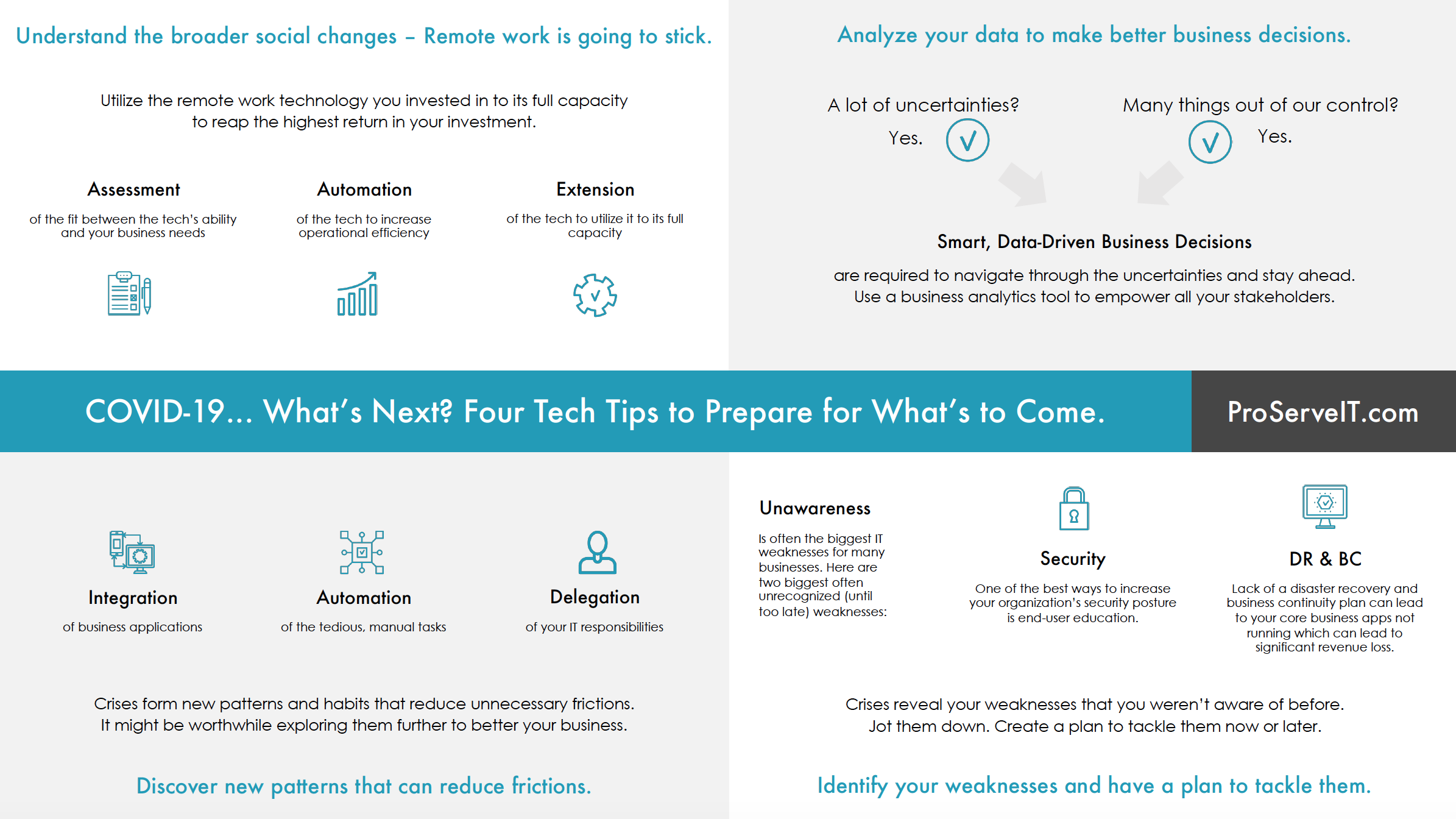By Mihae Ahn, MBA, Director of Marketing, ProServeIT Corporation
There are three distinct phases with COVID-19: 1) Flatten; 2) Fight; and 3) Future. During the Flatten phase, countries have been fighting to reduce the spread and flatten the curve of the impacts of COVID-19. The Fight phase comes when the initial emergency is behind us and the efforts to restart the economy begins, while simultaneously, leaders are still carefully monitoring the possibility of a second or tertiary wave of the virus. When a vaccine or other effective treatment of the virus becomes available, we can finally get into the Future phase (Source: BCG).
What does it mean for businesses?
Depending on where we live and where our business operates, we are in either the middle or end stage of the Flatten phase or we’ve entered the Fight phase. This is the time for business leaders to think strategically. This is the time to proactively create a preparedness plan to win when we get to the Future phase. When you have a preparedness plan, you can create a priority list to execute the items in the order of importance and urgency. Your preparedness plan and priority list will help you understand what actions need to be taken now, and in the future, and this will help you stay ahead, rather than falling behind (Source: The 7 Stage Advisors).
Business leaders in the digital world we live in understand that their technology roadmap goes hand in hand with their business roadmap. When your IT capabilities are aligned with your business needs, your business can fly at a light speed without too much friction. Here are four tips that can come in handy when you build your preparedness plan.

Tip 1. Understand the broader social changes - Remote work is going to stick.
Remote work has been widely adopted to fight COVID-19 and it is going to stick. Even when the restrictions placed during the initial Flatten phase are removed one by one, our life will not go back to the one we had pre COVID-19; at least not until we are in the Future phase. Many people will still work remotely, out of necessity or by choice, during the remainder of the Flatten and the Fight phases.
Is the remote work technology you adopted being fully utilized by everyone in your organization? You want to ensure your investment in remote work technology brings you the best return you can possibly hope for.
Microsoft Office 365 is the most widely used collaboration platform and with Microsoft Teams (Teams) included with Office 365 licenses at no extra cost, many more businesses have adopted Teams during the initial Flatten phase of COVID-19. Microsoft saw 12 million new users adopted Teams in the beginning of the Flatten phase.
Technology brings you the highest return when it is widely adopted and utilized to its full capacity. Every business and every industry is different and each technology uniquely meets their business needs. Many of our customers mentioned that a Teamwork Assessment has been one of the best ways to assess that alignment.
Another recommendation from us is to think outside of box to achieve efficiency:
Modernize your phone system with Teams
Only 47% of the businesses, who responded to our Remote Work Readiness Assessment, provided company-issued devices to all of their employees. When your office workers who deal with a high volume of incoming calls on a daily basis don't have company-issued devices and need to work from home, thy can’t be as productive as they can be. Teams has the potential to replace your organization's current phone system, meaning that everyone in your organization can have access to their "phone" regardless of their location or the type of device they’re using. This can help ensure your employees stay productive while working remotely. Take advantage of our upcoming Teams Voice webinar to understand how this aligns with your business’s needs, both short-term and long-term.
Automate Teams for best ROI
In addition to the commonly used Instant Messaging (IM) and collaboration capabilities of Teams, it can also become a "Smart" platform that automates some of your manual processes. Those businesses who have explored and utilized the additional capabilities of Teams in a creative way (such as automation) have seen higher ROI in their technology investment while increasing operational efficiency and employee satisfaction. Here are additional resources that can help you imagine your ways of turning Teams smarter:
Tip 2. Analyze your data to make better business decisions during the uncertain time.
Now more than ever, it is important to make business decisions based on the data you have available. Yes, there are many uncertainties we can’t control or predict. But we do have control over how we use our own data to make business decisions. As more of your operations became digitized to allow remote work, more data has been collected within your IT environment.
When the right business analytics tool is integrated with your core business applications and departmental applications, you can dissect, analyze, and visualize the data in the manner that helps all your stakeholders to make smart, data-driven business decisions.
If you are using Microsoft Office 365, Power BI, one of the leading business analytics tools used by numerous businesses, can be the best option to explore. Contact us if you would like to hear about how our customers have been using it to make data-driven decisions.
Tip 3. Discover new patterns that can reduce frictions.
We aren’t going to emerge from COVID-19 the same company that we were before the pandemic. Have you noticed any new patterns emerging as you’ve been coping with the pandemic? Have any of those new patterns or new habits actually reduced frictions and helped to get things done?
Some of these new habits will likely be tossed out (rightly so) once the restrictions are lifted. But how about those that helped to reduce friction? Crises, like this pandemic, are the birthplace of innovation. Here are some suggestions that can spark your own innovative ideas:
Integration of applications
Are there ways to integrate your applications to make information flow better? When the numerous business applications you are using are integrated and can “talk to each other”, your organization’s efficiency skyrockets.
Automation
Are there tedious manual tasks that can be automated? According to Gartner, one of the top 10 strategic technology trends is hyper-automation (i.e. automate anything and everything you can automate). Got any ideas of what you’d love to automate so that you can free up your time to spend it on what brings you the highest value? Now might be the best time to jot down your ideas.
Delegation of IT Responsibilities
Our customers have achieved efficiency by delegating their non-core competencies to a partner or vendor. This has helped them not only reduce cost but also increase the value per dollar spent. For many of our customers, IT isn't their core competency. How about you? Delegating IT responsibilities to an experienced vendor can be one of the ways to reduce friction while achieving efficiency long-term.
Tip 4. Identify your weaknesses and have a plan to tackle them.
There is always a chance to turn a lemon into lemonade, isn't there? Trying to cope with the unprecedent, global-scale pandemic opens our eyes to the weaknesses in our business operations and processes that we hadn't previously been aware of. Many of the business leaders we have talked to – no matter their size, industry, or geographic location – mentioned that they are taking this as an opportunity to create a plan to tackle their own weaknesses and inefficiencies.
Depending on the degree of COVID-19 impact to your business, you may be able to take actions now to tackle your identified weaknesses. Or, it may make sense to tackle them later in few weeks or months, once you’ve been able to take stock of everything that COVID-19 has done. But what everyone can do now is to make note of weaknesses when recognized. This will help you remember and come back to them when you have the capacity to do so.
When it comes to IT weakness, the biggest one of all is not being aware of what your weaknesses are. Here are the common weaknesses that business leaders do not typically recognize:
Security
As office workers who usually worked in the office adopted the work-from-home model, some of them were left with no other alternatives but to use their personal devices to work, which posed a serious security concern and increased the likelihood of a breach. With the right security measures in place, BYOD (Bring Your Own Device) policies can work without compromising your corporate IT environment. One of the beset ways that you can ensure you are increasing your organization’s security posture is end-user training and education. Download our eBook for tips on safe computing practices.
Disaster Recovery & Business Continuity
Another common unrecognized weakness is the absence of (or lack of) a disaster recovery and business continuity plan. Here is a scenario to help you access whether your business has a disaster recovery and business continuity plan. Your data (emails in your inbox, internal documents, customer-facing documents like proposals, contracts, presentation decks, any information saved in your business applications, etc.) is only saved in your server that is in your office's server room. There is a power outage (or any other small or big disasters) and your server is down. This means your core business applications and other applications your people work with on a daily basis will not function. During the lockdown, your IT staff is working from home and can't get to your office to remediate the issue in a timely manner. How long can your business continue to operate without your business applications fully running? Do you have a plan in case this happens? Read our blog to help you understand how to address this often unrecognized weakness.
 Coming from the non-IT world prior to her career at ProServeIT, Mihae fully understands business leaders' challenges of connecting the dot between their business roadmap and their technology roadmap. She is passionate about creating and providing the content that can help business leaders identify and close that gap.
Coming from the non-IT world prior to her career at ProServeIT, Mihae fully understands business leaders' challenges of connecting the dot between their business roadmap and their technology roadmap. She is passionate about creating and providing the content that can help business leaders identify and close that gap.
Connect with Mihae via LinkedIn
Tags:
Technology Advisory
April 28, 2020



Comments